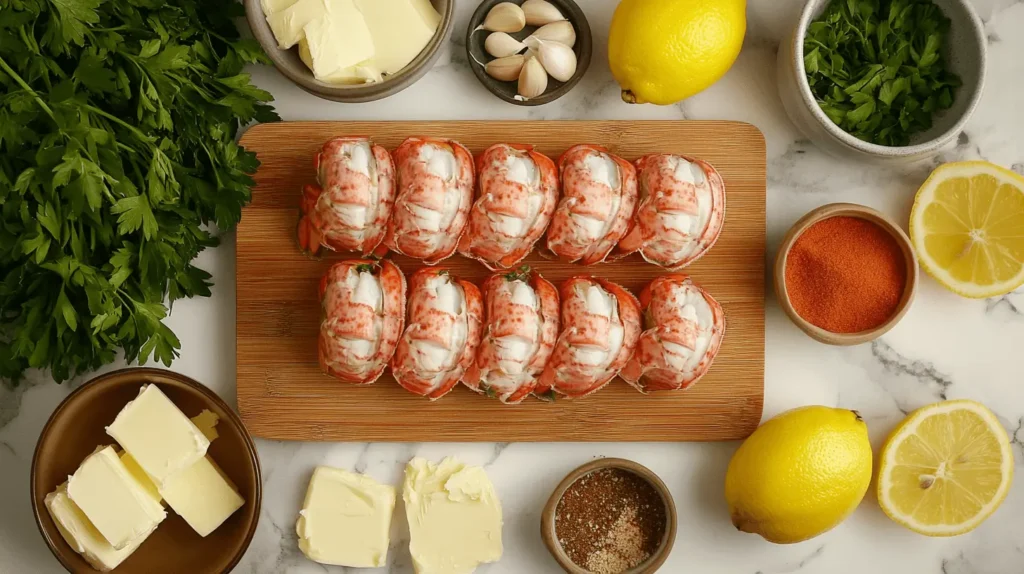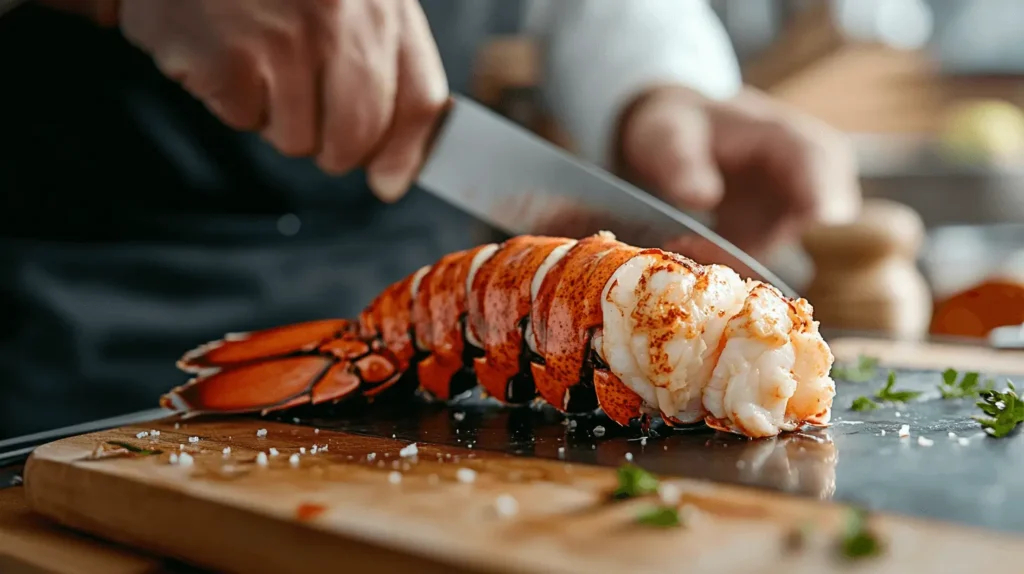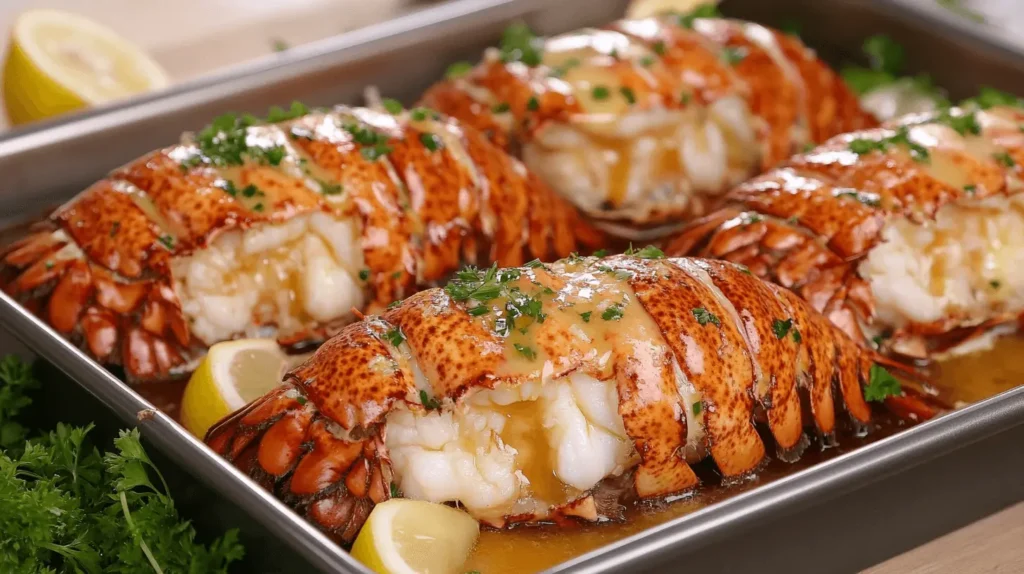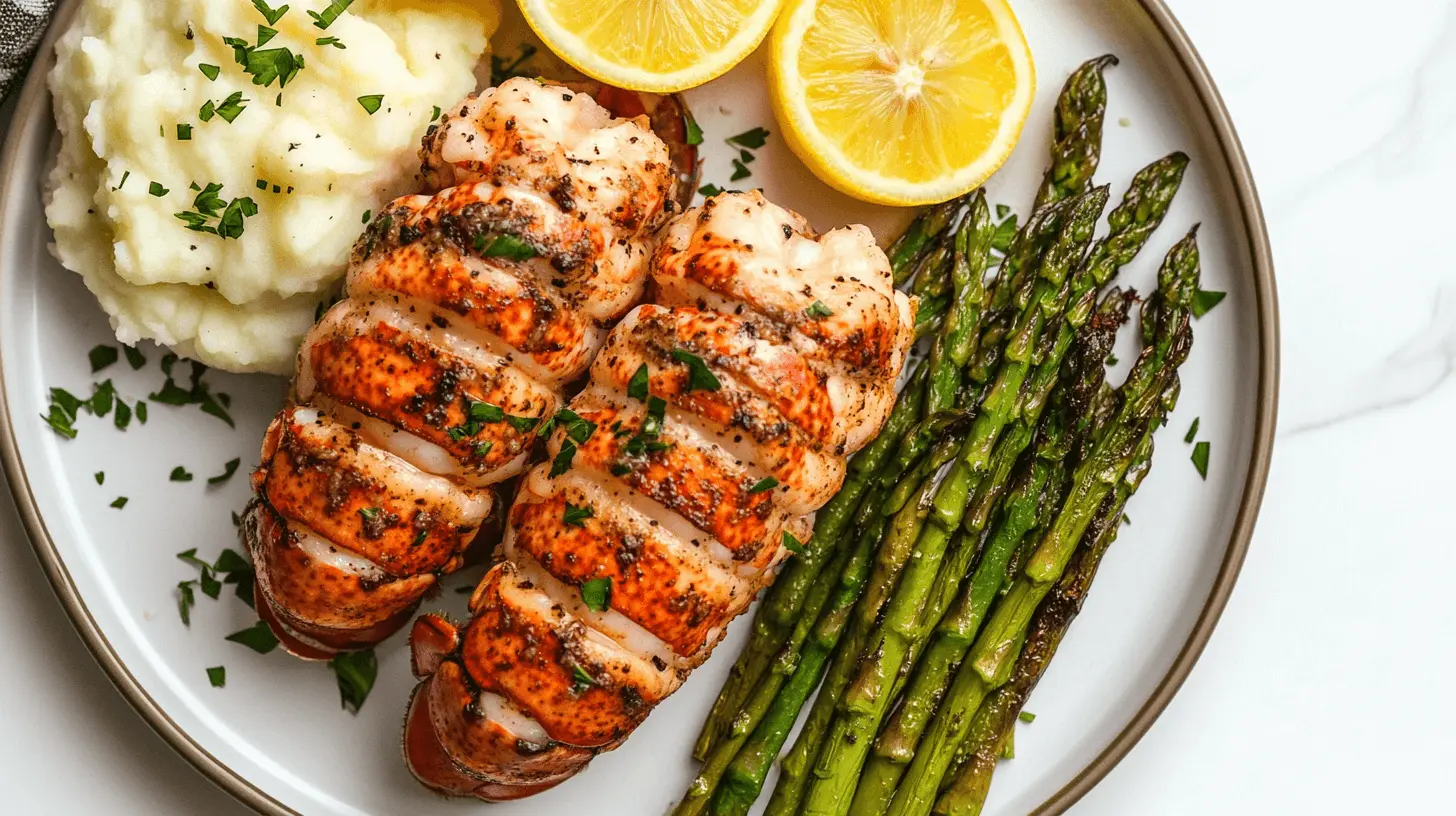Introduction to Baked Lobster Tails
When it comes to crafting a truly memorable dining experience, few dishes command as much attention and admiration as baked lobster tails. Renowned for their delicate, buttery flavor and luxurious presentation, lobster tails are a top choice for special occasions and gourmet meals alike. Whether you’re hosting an intimate dinner or celebrating a milestone, lobster tails add a touch of sophistication to any table.
Why Choose Lobster Tails for a Special Meal
Lobster tails are the epitome of elegance in seafood cuisine. Their rich, succulent meat pairs beautifully with a variety of seasonings, from classic butter and garlic to more adventurous herb-infused blends. Beyond their taste, lobster tails are surprisingly easy to prepare, especially when baked, making them an excellent choice for home cooks looking to impress without excessive effort. Their compact size and pre-portioned nature ensure that they cook evenly, delivering a perfect balance of tenderness and flavor.
The Popularity of Lobster Tails in Culinary Arts
In the world of fine dining, lobster tails have long held a prestigious place. Chefs around the globe celebrate their versatility, using them as the centerpiece in dishes that range from traditional New England lobster feasts to innovative fusion cuisine. Their mild flavor provides a perfect canvas for creative culinary techniques, such as broiling, grilling, and baking. Moreover, the visual appeal of a beautifully plated lobster tail, with its vibrant shell and juicy meat, makes it a favorite among food stylists and restaurateurs alike.
By choosing lobster tails, you’re not just selecting a meal; you’re creating an experience that embodies luxury, flavor, and a touch of the extraordinary. Whether paired with a glass of crisp white wine or accompanied by a side of decadent mashed potatoes, baked lobster tails are sure to elevate any occasion.
Ingredients Needed for Baked Lobster Tails
Creating the perfect baked lobster tails starts with selecting the right ingredients. With a blend of essential components and optional enhancements, you can craft a dish that is both flavorful and visually stunning.

Key Ingredients for an Authentic Recipe
- Lobster Tails: The star of the dish, choose fresh or high-quality frozen lobster tails for the best results. Opt for medium to large tails for a balance of tenderness and flavor.
- Unsalted Butter: A staple in most lobster tail recipes, melted butter adds richness and a smooth, creamy texture to the dish.
- Garlic: Minced fresh garlic infuses the lobster meat with a bold, aromatic flavor that complements its natural sweetness.
- Lemon Juice: Freshly squeezed lemon juice provides a bright, tangy contrast to the buttery richness, enhancing the overall taste.
- Paprika: This mild spice not only adds a hint of earthy flavor but also gives the lobster tails a beautiful golden-red hue.
- Salt and Pepper: Simple yet essential seasonings to bring out the natural flavors of the lobster.
Optional Ingredients for Enhanced Flavor
- Parsley: Finely chopped fresh parsley adds a burst of color and a subtle herbal note to the finished dish.
- Chili Flakes: For those who enjoy a bit of heat, a sprinkle of chili flakes can elevate the flavor profile.
- Parmesan Cheese: A light dusting of grated Parmesan creates a decadent, slightly nutty crust when baked.
- White Wine: A splash of dry white wine can be added to the butter mixture for a touch of elegance and depth.
- Honey or Maple Syrup: For a unique twist, a small drizzle of honey or maple syrup can enhance the lobster’s natural sweetness.
With these ingredients in hand, you’re ready to prepare baked lobster tails that are as delicious as they are visually appealing. Whether sticking to the basics or experimenting with optional additions, each bite promises to be a culinary delight.
Step-by-Step Preparation Guide
Preparing baked lobster tails is a straightforward process that ensures a gourmet meal with minimal effort. Follow these steps for cleaning, prepping, and handling your lobster tails safely to achieve the best results.

Cleaning and Prepping Lobster Tails
- Thawing: If using frozen lobster tails, allow them to thaw in the refrigerator overnight or place them in a bowl of cold water for faster defrosting. Avoid using warm water, as it can compromise the texture of the meat.
- Rinsing: Rinse the thawed lobster tails under cold water to remove any debris or ice crystals. Pat them dry with paper towels.
- Cutting the Shell: Using kitchen shears, carefully cut through the top of the lobster shell lengthwise, stopping just before the tail fin. Avoid cutting into the meat.
- Butterflying the Meat: Gently pry the shell apart and lift the meat up, resting it on top of the shell while keeping the end attached. This technique ensures even cooking and an attractive presentation.
- Removing the Vein: Check for and remove the dark vein (the digestive tract) running along the top of the meat using a knife or your fingers. Rinse again if necessary.
Tips for Handling Lobster Safely
- Freshness Matters: Ensure the lobster tails are fresh or properly frozen to avoid any foodborne illnesses.
- Work Quickly: Once thawed, prepare and cook the lobster tails promptly to maintain quality.
- Keep Surfaces Clean: Use separate cutting boards and tools for raw lobster to prevent cross-contamination.
- Wash Hands: Always wash your hands thoroughly before and after handling seafood.
The Perfect Marinade for Lobster Tails
A good marinade can elevate the flavor of your lobster tails, whether you prefer classic simplicity or adventurous combinations.
Traditional Marinade Options
- Garlic Butter Marinade:
- Melted unsalted butter
- Minced garlic
- Freshly squeezed lemon juice
- Salt and pepper
Combine these ingredients to create a classic and rich marinade that enhances the lobster’s natural sweetness.
- Herb-Infused Olive Oil:
- Extra-virgin olive oil
- Freshly chopped parsley, thyme, or rosemary
- Lemon zest
- Crushed garlic cloves
This light and aromatic marinade adds a refreshing herbal note to the dish.
Creative Marinade Variations
- Spicy Citrus Marinade:
- Lime or orange juice
- Chili flakes or cayenne pepper
- Honey or agave syrup
- Soy sauce
Perfect for those who enjoy a tangy, sweet, and spicy flavor combination.
- Asian-Inspired Marinade:
- Soy sauce
- Sesame oil
- Grated ginger
- Rice vinegar
- A touch of brown sugar
This savory and umami-packed marinade offers a fusion twist to traditional lobster preparation.
- Tropical Coconut Marinade:
- Coconut milk
- Lime juice
- Fresh cilantro
- A pinch of turmeric or curry powder
This creamy and exotic marinade is ideal for a Caribbean-inspired seafood experience.
By selecting the right marinade, you can tailor your baked lobster tails to match your desired flavor profile, ensuring a delicious and memorable meal every time.
Baking Techniques for Lobster Tails
Mastering the baking process ensures lobster tails are cooked to perfection, with tender meat and a rich, flavorful finish. Here’s a detailed guide to achieve optimal results.

Ideal Baking Temperature and Time
- Temperature: Preheat your oven to 425°F (220°C) for optimal baking results. This temperature ensures the lobster tails cook evenly without drying out.
- Baking Time:
- Lobster tails typically take 10-12 minutes for medium-sized tails (5-6 ounces each).
- Larger tails may require up to 15 minutes, but always monitor closely to avoid overcooking.
- Checking for Doneness: The meat should turn opaque and white, with an internal temperature of 140-145°F (60-63°C) when checked with a meat thermometer.
How to Avoid Overcooking
- Watch Closely: Lobster meat cooks quickly. Begin checking for doneness a few minutes before the expected cooking time ends.
- Use a Meat Thermometer: This ensures precise cooking and prevents guesswork.
- Butter Basting: Brushing the meat with melted butter during baking helps retain moisture and prevents drying out.
- Tent with Foil: If the lobster tails are browning too quickly, cover them loosely with aluminum foil to regulate heat exposure.
Alternatives to Baking Lobster Tails
While baking is a popular method, steaming and grilling offer delicious alternatives, each with unique advantages.
Steaming or Grilling Options
- Steaming:
- How it Works: Lobster tails are cooked over boiling water, capturing steam in a covered pot or steamer basket.
- Cooking Time: Around 7-10 minutes, depending on size.
- Best For: Preserving the natural sweetness and moisture of the lobster meat.
- Grilling:
- How it Works: Lobster tails are cooked over an open flame or on a grill pan, often basted with butter or marinade.
- Cooking Time: Approximately 8-10 minutes, flipping halfway through.
- Best For: Adding a smoky, charred flavor that complements the lobster’s natural taste.
Pros and Cons of Each Method
| Method | Pros | Cons |
|---|---|---|
| Baking | Even cooking, rich flavor, easy preparation | Requires careful timing to avoid overcooking |
| Steaming | Retains moisture, enhances natural flavor | Lacks the caramelization or browning of baking/grilling |
| Grilling | Smoky flavor, crispy texture | Requires outdoor setup or special equipment |
Whether you prefer the simplicity of steaming, the bold flavor of grilling, or the reliable elegance of baking, each method offers a unique way to enjoy the exquisite taste of lobster tails. Experiment with different techniques to find your favorite!
Side Dishes to Complement Baked Lobster Tails
A beautifully baked lobster tail deserves equally delightful side dishes to complete the meal. Whether you prefer classic pairings or gourmet creations, these options will enhance the flavors of your main dish.
Classic Pairings: Salads, Potatoes, and More
- Salads:
- A crisp, refreshing Caesar salad with romaine, Parmesan, and croutons pairs perfectly with the richness of lobster.
- Mixed greens with a citrus vinaigrette provide a bright, tangy contrast to the buttery lobster meat.
- Potatoes:
- Creamy garlic mashed potatoes or buttery baked potatoes complement lobster tails with their hearty texture.
- Roasted baby potatoes seasoned with rosemary and olive oil offer a flavorful, crispy side.
- Vegetables:
- Steamed asparagus or green beans drizzled with hollandaise sauce are classic lobster accompaniments.
- Roasted Brussels sprouts with balsamic glaze add a sweet and savory element to the plate.
- Bread:
- Warm, crusty French bread or soft dinner rolls are perfect for soaking up any leftover butter sauce.
Gourmet Side Dish Suggestions
- Risotto:
- A creamy Parmesan risotto or a lemon herb risotto elevates the meal with its rich texture and complementary flavors.
- Pasta:
- Lobster mac and cheese, with its decadent blend of cheese and lobster, is a luxurious side dish option.
- Grain Bowls:
- Quinoa or farro bowls with roasted vegetables and herbs add a nutritious and sophisticated touch.
- Soups:
- A light lobster bisque or clam chowder served as a starter can set the tone for a seafood-themed dinner.
Serving Suggestions for Lobster Tails
Presentation is key to making lobster tails the centerpiece of a stunning dining experience.
Plating and Presentation Tips
- Use Elegant Serveware: Serve lobster tails on white or neutral-colored plates to make the vibrant shell and meat stand out.
- Garnish Thoughtfully: Add a sprinkle of chopped parsley, a wedge of lemon, or a drizzle of melted butter for a polished look.
- Balance the Plate: Arrange side dishes symmetrically around the lobster tail for an aesthetically pleasing presentation.
- Layer Textures: Place lobster tails on a bed of greens, risotto, or creamy sauce to create depth and contrast.
Accompaniments for a Complete Dining Experience
- Dipping Sauces:
- Classic drawn butter with garlic and lemon is a must-have.
- Herb-infused butter or spicy aioli can add a creative twist.
- Beverages:
- Pair lobster tails with a crisp white wine such as Chardonnay or Sauvignon Blanc.
- For a non-alcoholic option, a sparkling lemonade or iced tea with a citrus slice complements the dish well.
- Dessert:
- A light dessert, such as lemon sorbet or fruit tart, provides a refreshing finish to the meal.
- Chocolate-covered strawberries or crème brûlée add a touch of indulgence to complete the dining experience.
With thoughtful side dishes, presentation, and accompaniments, your baked lobster tail dinner will be as unforgettable as it is delicious.
Nutritional Benefits of Lobster Tails
Lobster tails are not only a luxurious and flavorful dish but also a nutritious choice packed with essential nutrients that support a healthy lifestyle.
Protein and Vitamin Content
- High-Quality Protein: Lobster tails are an excellent source of lean protein, providing the building blocks needed for muscle growth, tissue repair, and overall body function. A single lobster tail contains approximately 19 grams of protein, making it a satisfying and nutritious main course.
- Rich in Vitamins and Minerals:
- Vitamin B12: Lobster is a significant source of vitamin B12, which supports nerve health and red blood cell production.
- Zinc: Helps strengthen the immune system and aids in wound healing.
- Selenium: Acts as an antioxidant, protecting the body from oxidative stress and promoting thyroid function.
- Omega-3 Fatty Acids: Lobster tails contain healthy fats that benefit heart health, brain function, and inflammation control.
How Lobster Fits into a Balanced Diet
- Low in Fat: Compared to many other protein sources, lobster is naturally low in fat, making it suitable for weight-conscious diets when prepared without excessive butter or cream.
- Low in Calories: A lobster tail averages around 90 calories, depending on size and preparation, making it a nutrient-dense option for those managing calorie intake.
- Versatile and Adaptable: Lobster can be paired with a variety of healthy sides such as steamed vegetables, whole grains, or fresh salads to create a well-rounded and balanced meal.
Common Mistakes to Avoid
Even experienced cooks can make errors when preparing lobster tails, which can affect the final dish. Here are the most common mistakes and how to avoid them.
Overcooking the Lobster
- Why It Happens: Lobster meat cooks quickly and can become rubbery and tough if left in the oven too long.
- How to Avoid It:
- Use a meat thermometer to ensure the internal temperature reaches 140-145°F (60-63°C).
- Monitor cooking times closely, checking for doneness early.
- Follow recommended cooking techniques, such as butter basting, to maintain moisture.
Using the Wrong Spices
- Why It Happens: Lobster has a delicate flavor that can be overpowered by strong or mismatched seasonings.
- How to Avoid It:
- Stick to simple, complementary seasonings like garlic, lemon, and herbs.
- Avoid heavy-handed use of overpowering spices such as cumin, curry, or excessive chili unless you’re following a specific fusion recipe.
- Taste your marinade or seasoning blend before applying it to ensure it enhances rather than masks the natural flavor of the lobster.
By understanding the nutritional benefits and avoiding common cooking mistakes, you can confidently prepare lobster tails that are both healthy and delicious.
FAQs About Baked Lobster Tails Recipe
Baking lobster tails is a straightforward process, but common questions can arise when preparing this luxurious dish. Here are answers to some frequently asked questions to ensure your lobster tails turn out perfectly every time.
How Long Do I Bake Lobster Tails?
The baking time for lobster tails depends on their size:
- Medium-sized tails (5-6 ounces): Bake at 425°F (220°C) for 10-12 minutes.
- Larger tails (7-10 ounces): Bake at 425°F (220°C) for 12-15 minutes.
Tip: Always check for doneness by ensuring the meat is opaque and white, with an internal temperature of 140-145°F (60-63°C). Avoid overbaking, as it can lead to tough, rubbery meat.
What Size Lobster Tails Should I Use?
The size of lobster tails you choose depends on your serving needs:
- 5-6 ounces: Ideal for single servings or as part of a multi-course meal.
- 7-10 ounces: Perfect for larger portions or as the main feature of a plate.
Recommendation: Look for tails with a firm texture and vibrant color, as these indicate quality. Frozen lobster tails are a convenient and widely available option; just ensure they’re properly thawed before cooking.
Can I Prepare Lobster Tails Ahead of Time?
Yes, lobster tails can be prepped ahead to save time:
- Thawing: Thaw the tails in the refrigerator overnight if using frozen.
- Cleaning and Cutting: Butterfly the lobster tails and remove the vein, as outlined in preparation steps.
- Marinating: Apply your chosen marinade and store the tails in an airtight container in the refrigerator for up to 4 hours before baking.
Note: For optimal freshness and texture, avoid prepping lobster tails more than a day in advance. Always bake just before serving for the best results.
By following these guidelines, you’ll have all the information needed to prepare, bake, and serve lobster tails with confidence and ease.


5 thoughts on “The Ultimate Guide to Baked Lobster Tails: Recipes, Tips & FAQs”